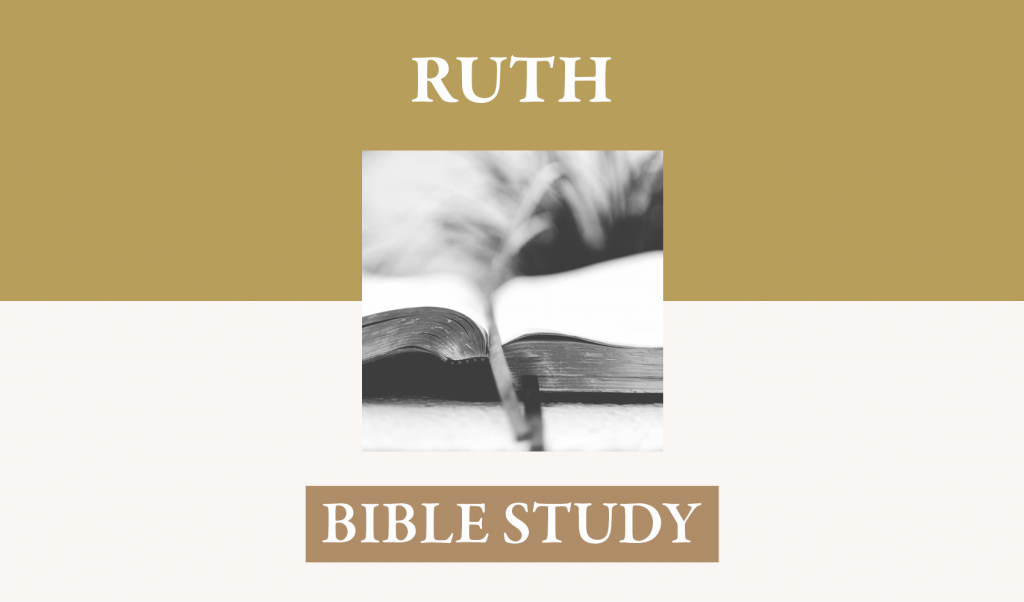Week of October 29, 2017
The Point: Christ-centered living chooses commitment, not convenience.
Ruth’s Steadfastness: Ruth 1:6-18.
[6] Then she arose with her daughters-in-law to return from the country of Moab, for she had heard in the fields of Moab that the LORD had visited his people and given them food.[7] So she set out from the place where she was with her two daughters-in-law, and they went on the way to return to the land of Judah.[8] But Naomi said to her two daughters-in-law, “Go, return each of you to her mother’s house. May the LORD deal kindly with you, as you have dealt with the dead and with me. [9] The LORD grant that you may find rest, each of you in the house of her husband!” Then she kissed them, and they lifted up their voices and wept. [10] And they said to her, “No, we will return with you to your people.” [11] But Naomi said, “Turn back, my daughters; why will you go with me? Have I yet sons in my womb that they may become your husbands? [12] Turn back, my daughters; go your way, for I am too old to have a husband. If I should say I have hope, even if I should have a husband this night and should bear sons, [13] would you therefore wait till they were grown? Would you therefore refrain from marrying? No, my daughters, for it is exceedingly bitter to me for your sake that the hand of the LORD has gone out against me.” [14] Then they lifted up their voices and wept again. And Orpah kissed her mother-in-law, but Ruth clung to her. [15] And she said, “See, your sister-in-law has gone back to her people and to her gods; return after your sister-in-law.” [16] But Ruth said, “Do not urge me to leave you or to return from following you. For where you go I will go, and where you lodge I will lodge. Your people shall be my people, and your God my God. [17] Where you die I will die, and there will I be buried. May the LORD do so to me and more also if anything but death parts me from you.” [18] And when Naomi saw that she was determined to go with her, she said no more. [ESV]
“The book of Ruth is part of the biblical narrative of redemptive history. It describes one more stage in the purposes of God as they moved inexorably towards the final redemption of His people through Jesus Christ. The book of Ruth focuses like a microscope on part of the detailed preparation God made in order to fulfil His purposes in redemptive history. Apparently the story of a small and insignificant family, it is actually one of the building blocks in God’s preparatory work as He sovereignly directed history towards the coming of the Savior Jesus Christ. In fact, the message of the book of Ruth cannot be fully understood apart from the coming of our Lord Jesus Christ. It shows us in miniature form, but in considerable detail, how wise God’s sovereign purposes really are. We are not able to detect with perfect clarity the hand of God in the circumstances of our lives, far less see where He is heading with them. But when we find His autograph in the narratives of biblical history, we begin to recognize the same or similar patterns and principles emerging in our own lives too – and so we learn to see His handwriting in our own experiences. In the book of Ruth, God allows us to see the kind of thing He does, so that we may trust Him when we see similar patterns being woven into our own lives. At the time, of course, what God was accomplishing in the lives of Naomi, Ruth and Boaz was far from clear to any of them. Right at the end of the story, the author shows how God was doing far more than they could have realized during their lifetimes. What we see in the narrative sections of the Bible is the way in which God takes up ordinary people into His purposes and uses them in ways inexplicable in terms of the ordinary. In these passages and books God shows us how He sovereignly works out His perfect will. The first chapter of Ruth describes three parts of a spiritual journey. Each of these segments brings us to a different geographical location. These are like stations o the rail track of God’s grace. He means us to pause at each of them to learn something new about how He works in the affairs of His children. The first scene [1:1-5] describes the journey of a family who emigrate east from Bethlehem to the land of Moab, and it is largely set in that pagan country. The second scene, in the central part of the chapter [1:6-18], takes place a decade or so later. It describes a return journey from Moab. The action is located at a crossroads between Moab and Bethlehem. Here we are invited to pause and reflect on the way in which God is moving His sovereign purposes forwards. The chapter (indeed, the rest of the book) ends back in Bethlehem [1:19-22]. Our passage is concerned with the second scene. This scene is the turning point, both geographically and also spiritually, of the entire book. The repeated use of a Hebrew verb in this scene gives the reader a clue to the plot and meaning of the story. This verb is translated return [6,7,8,10,16,22]; turn back [11,12]; gone back [15]; brought back [21]. The constant repetition of this particular verb is significant because it is not only the Hebrew word for return, but it is the Old Testament’s main word for turning back to God’s covenant grace and mercy – for repentance, for conversion. By using this theologically important term, the author of Ruth is giving us a hint: “Do you see what God is doing here? This is a conversion.” This is a story about turning back to God. It is about returning to His grace. Indeed, this is one of the greatest – and perhaps the most detailed – account in the Old Testament of how God sovereignly works to bring someone to faith.
Scene One [1:1-5]. Scene one takes us from Bethlehem to Moab. It tells a story of the need and suffering of a small family, of wrong steps taken to deal with their difficulties, and of disastrous consequences. Yet it also underlines that the saving purposes of God ordinarily begin in His hidden, and sometimes dark, providences. Frequently God’s hand is placed on the sufferings and trials of an individual in order for His grip to take hold of someone else. The story takes place during the time of the judges which is best described in the last verse of the book of Judges: In those days there was no king in Israel. Everyone did what was right in his own eyes [Judges 21:25]. The famine in the land is seen as God’s curse upon the covenant unfaithfulness of the people. Through means of the famine God is calling upon His people to return to Him in repentance and faithfulness. Thus we are introduced to Elimelech, his wife Naomi, and their two sons Mahlon and Chilion. God is saying to this family, as well as to the whole nation: ‘Repent of your sins. Return to me. Call upon me and I will have mercy on you. I will come to you with forgiveness and grace.’ But instead of turning back to the Lord, this little family turn their backs on the Lord, and go to live in Moab, a country associated with pagan religion and worship. Thus this family is forsaking the only place on earth God has specifically given to His people, the place in which he has promised to bless them and provide for all their needs. Do Elimelech and Naomi intend only a brief sojourn? Ten years later Naomi is still there [1:4]. When we turn our backs on the Lord’s word we never intend to do it for long. It is only going to be for a little while, over a small matter. But it rarely works out that way. During those ten years Naomi finds herself in a personal nightmare. First of all, her husband dies. Then the two boys – predictably – marry Moabite women. But worse is to come. Naomi’s two sons die. In these cruel losses, she must feel that God has thrust His sword into her heart: the hand of the Lord has gone out against me [1:13]. The Almighty has dealt very bitterly with me [1:20].
Scene Two [1:6-18]. God is working like a skilled surgeon in the life of Naomi. The painful surgery is part of a healing process. Thus, chastened by sore providence, Naomi seems to have been prepared by God to respond positively to the news she hears in Moab. The Lord has come to help His people by providing food for them [1:6]. Covenant blessings have returned; there is a supply of food again for the needy. The Lord opens Naomi’s heart, and graciously brings her back through bitter experiences to His blessing. Naomi arose … to return. Here we have the first of ten uses in chapter one of this special Hebrew word which describes a turning back to God for repentance. Naomi’s return gives us some insight into what motivates genuine repentance towards God, what the New Testament calls repentance that leads to life [Acts 11:18]. Her (and our) need for repentance is, of course, rooted in the fact of sin and the subsequent judgment and condemnation of God’s holy law. But knowing we are condemned does not – on its own – lead us to repentance. That requires God’s covenant mercy – the good news that there is food in Bethlehem: the Lord had visited his people and given them food [1:6]. The Lord has come to the aid of His people. Naomi plans to return to Bethlehem. Her daughters-in-law express a desire to go with her. They leave the place where they have been living and set out on the road that will take them back to the land of Judah. At some point on this journey Naomi stops and addresses Orpah and Ruth. It becomes the decisive turning point in each of their lives. You can tell that there has been a turning point and a change in Naomi’s own life, first, by the way she speaks to her daughters-in-law in 1:8-9: Go, return each of you to her mother’s house. May the Lord deal kindly with you … The Lord grant that you may find rest, each of you in the house of her husband. Orpah does go back. But Ruth remains, insisting that she will go with her mother-in-law, despite Naomi’s urging. From one point of view, Naomi is giving Ruth humane advice. But in another sense, Naomi is doing something she could never have done when she and Ruth were living together in the land of Moab. She is talking to her about the cost of belonging to the Lord’s covenant people – the cost of discipleship. Why does Naomi speak of these implications now? Because she wants Ruth to abandon herself to pagan ways? Surely not! Naomi is doing what she has probably never done, indeed, could not have done, in Moab. She is speaking about what may be involved in yielding to the grace of God. Nothing will be guaranteed to us except that His grace will be sufficient for all our needs, and that He will never be our debtor. There is no promise of financial security, far less material prosperity. God does not guarantee our comfort. Naomi is inviting her daughters-in-law to count the cost of belonging to the Lord. It might well mean: no husband; no guaranteed provision or security; no children; no human hope. Naomi has been changed. When the principles of discipleship were muted in her life in Moab, she could hardly speak clearly about it to her sons or their wives. But now she can speak with integrity – at last. We are similarly not able to witness with conviction and sincerity to those who ask us about Christ and all that is involved in discipleship when there is little or nothing in our own lives to authenticate what we say to them. But when the Lord restores us and we yield without reservation to Him, we can speak with a clear conscience. Naomi has come to know this. She is going back to be with the Lord and His people. She will experience His grace. Nothing else ultimately matters. She trusts that God will provide for her needs. But what about the girls? It is a turning point for Orpah. Presumably, given the marrying age in those days, she is still only in her mid-twenties – an eligible young woman, with the whole of life before her; still with the maternal instinct to bear children, although she is as yet barren. Orpah makes her decision. She chooses the familiar, the temporal and the visible. She opts for this world’s wisdom, and turns away from the wisdom of God. It is also a turning point for Ruth. See, your sister-in-law has gone back to her people and to her gods; return after your sister-in-law, challenges Naomi [1:15]. But in verses 16-17 Ruth gives her memorable reply: Do not urge me to leave you or to return from following you. For where you go I will go, and where you lodge I will lodge. Your people shall be my people, and your God my God. Where you die I will die, and there will I be buried. May the Lord do so to me and more also if anything but death parts me from you. And then we read: And when Naomi saw that she was determined to go with her, she said no more [1:18]. The words at the center of Ruth’s statement are the jewel in the crown of verses 16 and 17 and of the whole chapter: Your people shall be my people, and your God my God. Here is familiar Old Testament language. When God made His covenant with His people, He said, I will be your God, and you shall be my people [Lev. 26:12]. Those are the words with which God committed Himself to saving them. What Ruth is saying in response to Naomi, then is: ‘This God, who made His covenant with Abraham, who brought His people out of Egypt in the Exodus, who has promised to provide us with grace and salvation – Naomi, this is my God! That is why I am saying, your people shall be my people, and your God my God.’ That this is a narrative of a surprising conversion is further confirmed by the later words of Boaz when he first meets Ruth. The ‘gossip’ he has heard about her is that she has come to take refuge under the wings of the Lord, the God of Israel [2:12]. To shelter or hide under God’s wings is a common Old Testament expression for trusting in Him as covenant Lord [cf. Psalm 17:8; 36:7; 57:1; 61:4; 63:7; 91:4]. In the words Paul uses to describe the conversion of the Thessalonians, Ruth has turned to God from idols to serve the living and true God [1 Thess. 1:9]. Without reservation, with no limitation to her commitment both to the Lord and to the Lord’s people, this young woman has indeed been converted. This is the time to stand back for a moment and look at Naomi’s question? Lord, why me? As Naomi prepares to return to Bethlehem, she says, it is exceedingly bitter to me for your sake that the hand of the Lord has gone out against me [1:13]. As she looks back at her time in Moab, Naomi wonders why the Lord has brought so much bitterness into her life. It is the same question that we ask ourselves when God brings bitter providences into our own lives. In the case of Naomi, part of the answer is one word – in fact, a name: Ruth. Ruth’s conversion is part of the explanation for Naomi’s pain. That pain and God’s purposes have been woven together in a manner eloquently expressed by William Cowper in his hymn, ‘God moves in a mysterious way’: “Deep in unfathomable mines of never-failing skill, He treasures up his bright designs and works his sovereign will.” If you came across the first chapter of Ruth lying on the ground, and knew no more about the storyline than what this chapter contains, you might well wonder why the title of the book is Ruth. For this first chapter seems to be mainly centered on Naomi. Why does she feature so largely in the opening chapter of a book called Ruth? It is because the story of Naomi is about Ruth; or, more accurately, it is about God bringing Ruth to Himself and positioning her life in the ongoing unfolding of His purposes for the world. This is one reason why we can never say that there is a simple equation in Naomi’s life: “She sinned, therefore she is suffering.” God’s ultimate purpose has not been to punish her for her family’s spiritual failures in abandoning the land and the promises. Rather, through the mysterious intermingling of His providential control over history with Naomi’s family’s failures, the Lord’s purpose has been to reach through her life to bring Ruth to Himself. During Naomi’s extended stay in Moab God was ploughing. Now it is time for harvest to begin; now God is beginning to reap.” [Ferguson, pp. 11-41].
Questions for Discussion:
- What is the significance of there was a famine in the land [1]? What are the theological implications of God sending a famine upon His covenant people? What is God telling His people through the famine? What error did Elimelech make when he took his family to Moab?
- Ferguson writes: “This scene [1:6-18] is the turning point, both geographically and also spiritual, of the entire book.” Why does he say that? What is the importance of the repetition of “return” language in chapter one: return [3,7,8,10,16,22]; turn back [11,12]; gone back [15]; brought back [21]?
- The story of Naomi and Ruth illustrate the spiritual truth that the saving purposes of God ordinarily begin in His hidden, and sometimes dark, providences. Have you seen this true in your own life? How does this truth enable you to handle future “bitter providences” in your life?
References:
Ruth, Daniel Block, NAC, Broadman & Holman Publishers.
Faithful God, Sinclair Ferguson, Bryntirion Press.
Ruth, Leon Morris, Inter Varsity Press.





















